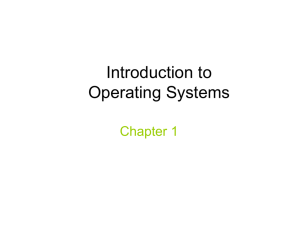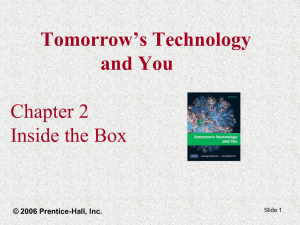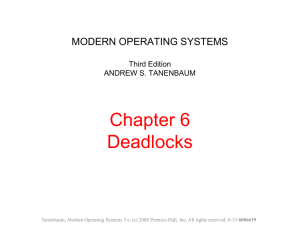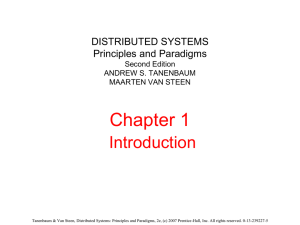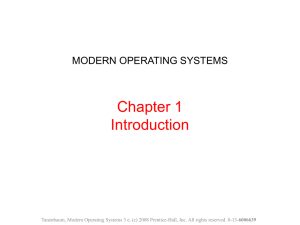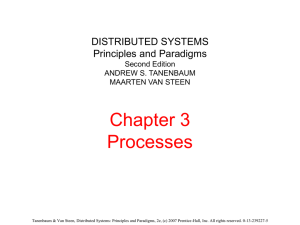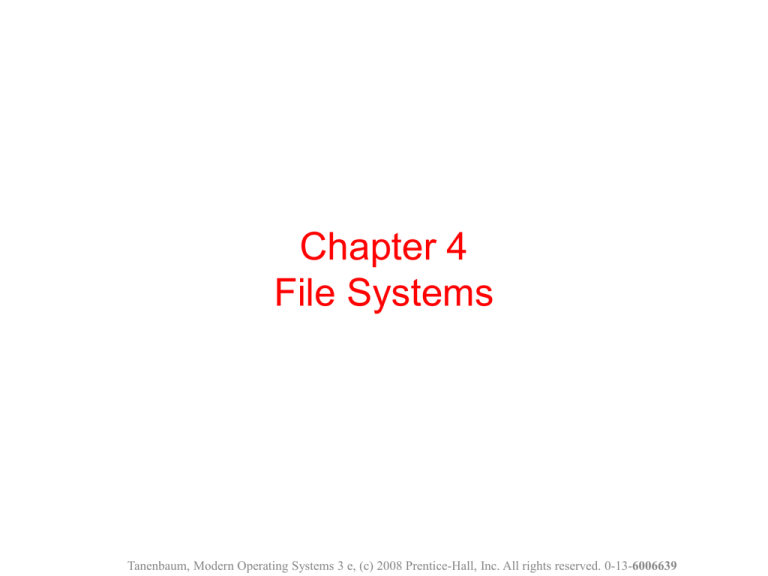
Chapter 4
File Systems
Tanenbaum, Modern Operating Systems 3 e, (c) 2008 Prentice-Hall, Inc. All rights reserved. 0-13-6006639
File Systems
•
•
•
Many important applications need to store more
information then have in virtual address space of
a process
The information must survive the termination of
the process using it.
Multiple processes must be able to access the
information concurrently.
Tanenbaum, Modern Operating Systems 3 e, (c) 2008 Prentice-Hall, Inc. All rights reserved. 0-13-6006639
File Systems
•
•
•
Disks are used to store files
Information is stored in blocks on the disks
Can read and write blocks
Tanenbaum, Modern Operating Systems 3 e, (c) 2008 Prentice-Hall, Inc. All rights reserved. 0-13-6006639
File Systems
•
•
•
•
Use file system as an abstraction to deal with accessing
the information kept in blocks on a disk
Files are created by a process
Thousands of them on a disk
Managed by the OS
Tanenbaum, Modern Operating Systems 3 e, (c) 2008 Prentice-Hall, Inc. All rights reserved. 0-13-6006639
File Systems
•
•
•
OS structures them, names them, protects them
Two ways of looking at file system
•
User-how do we name a file, protect it, organize the
files
•
Implementation-how are they organized on a disk
Start with user, then go to implementer
Tanenbaum, Modern Operating Systems 3 e, (c) 2008 Prentice-Hall, Inc. All rights reserved. 0-13-6006639
File Systems
•
The user point of view
•
Naming
•
Structure
•
Directories
Tanenbaum, Modern Operating Systems 3 e, (c) 2008 Prentice-Hall, Inc. All rights reserved. 0-13-6006639
Naming
One to 8 letters in all current OS’s
Unix, MS-DOS (Fat16) file systems discussed
Fat (16 and 32) were used in first Windows systems
Latest Window systems use Native File System
All OS’s use suffix as part of name
Unix does not always enforce a meaning for the
suffixes
DOS does enforce a meaning
Tanenbaum, Modern Operating Systems 3 e, (c) 2008 Prentice-Hall, Inc. All rights reserved. 0-13-6006639
Suffix Examples
.
Tanenbaum, Modern Operating Systems 3 e, (c) 2008 Prentice-Hall, Inc. All rights reserved. 0-13-6006639
File Structure
Byte sequences
Maximum flexibility-can put anything in
Unix and Windows use this approach
Fixed length records (card images in the old days)
Tree of records- uses key field to find records in the
tree
Tanenbaum, Modern Operating Systems 3 e, (c) 2008 Prentice-Hall, Inc. All rights reserved. 0-13-6006639
File Structure
Three kinds of files. (a) Byte sequence.
(b) Record sequence. (c) Tree.
Tanenbaum, Modern Operating Systems 3 e, (c) 2008 Prentice-Hall, Inc. All rights reserved. 0-13-6006639
File Types
•
•
•
•
Regular- contains user information
Directories
Character special files- model serial (e.g. printers) I/O
devices
Block special files-model disks
Tanenbaum, Modern Operating Systems 3 e, (c) 2008 Prentice-Hall, Inc. All rights reserved. 0-13-6006639
Regular Files
•
•
ASCII or binary
ASCII
•
Printable
•
Can use pipes to connect programs if they
produce/consume ASCII
Tanenbaum, Modern Operating Systems 3 e, (c) 2008 Prentice-Hall, Inc. All rights reserved. 0-13-6006639
Binary File Types
•
•
Two Unix examples
•
Executable (magic field identifies file as being
executable)
•
Archive-compiled, not linked library procedures
Every OS must recognize its own executable
Tanenbaum, Modern Operating Systems 3 e, (c) 2008 Prentice-Hall, Inc. All rights reserved. 0-13-6006639
Binary File Types (Early Unix)
(b)An archive-library
procedures compiled but
not linked
(a) An executable file (magic # identifiies it as an
Tanenbaum, Modern Operating Systems 3 e, ©
executable file)
File Access
•
•
Sequential access- read from the beginning, can’t skip
around
•
Corresponds to magnetic tape
Random access- start where you want to start
•
Came into play with disks
•
Necessary for many applications, e.g. airline
reservation system
Tanenbaum, Modern Operating Systems 3 e, (c) 2008 Prentice-Hall, Inc. All rights reserved. 0-13-6006639
File Attributes (hypothetical OS)
Tanenbaum, Modern Operating Systems 3 e, (c) 2008 Prentice-Hall, Inc. All rights reserved. 0-13-6006639
System Calls for files
:
•
•
•
•
•
•
Create -with no data, sets some attributes
Delete-to free disk space
Open- after create, gets attributes and disk addresses
into main memory
Close- frees table space used by attributes and
addresses
Read-usually from current pointer position. Need to
specify buffer into which data is placed
Write-usually to current position
Tanenbaum, Modern Operating Systems 3 e, (c) 2008 Prentice-Hall, Inc. All rights reserved. 0-13-6006639
System Calls for files
:
•
•
•
•
•
Append- at the end of the file
Seek-puts file pointer at specific place in file.
Read or write from that position on
Get Attributes-e.g. make needs most recent
modification times to arrange for group
compilation
Set Attributes-e.g. protection attributes
Rename
Tanenbaum, Modern Operating Systems 3 e, (c) 2008 Prentice-Hall, Inc. All rights reserved. 0-13-6006639
How can system calls be used?
An example-copyfile abc xyz
•
•
•
•
•
•
•
Copies file abc to xyz
If xyz exists it is over-written
If it does not exist, it is created
Uses system calls (read, write)
Reads and writes in 4K chunks
Read (system call) into a buffer
Write (system call) from buffer to output file
Tanenbaum, Modern Operating Systems 3 e, (c) 2008 Prentice-Hall, Inc. All rights reserved. 0-13-6006639
Copyfile abc xyz
...
Figure 4-5. A simple program to copy a file.
Tanenbaum, Modern Operating Systems 3 e, (c) 2008 Prentice-Hall, Inc. All rights reserved. 0-13-6006639
Copyfile abc xyz (2)
.
Tanenbaum, Modern Operating Systems 3 e, (c) 2008 Prentice-Hall, Inc. All rights reserved. 0-13-6006639
Directories
•Files which are used to organize a collection of
files
•Also called folders in weird OS’s
.
Tanenbaum, Modern Operating Systems 3 e, (c) 2008 Prentice-Hall, Inc. All rights reserved. 0-13-6006639
Single Level Directory Systems
A single-level directory system containing four files.
Tanenbaum, Modern Operating Systems 3 e, (c) 2008 Prentice-Hall, Inc. All rights reserved. 0-13-6006639
Hierarchical Directory Systems
Tanenbaum, Modern Operating Systems 3 e, (c) 2008 Prentice-Hall, Inc. All rights reserved. 0-13-6006639
Path names
•
•
•
•
Absolute /usr/carl/cs310/miderm/answers
Relative cs310/midterm/answers
. Refers to current (working) directory
.. Refers to parent of current directory
Tanenbaum, Modern Operating Systems 3 e, (c) 2008 Prentice-Hall, Inc. All rights reserved. 0-13-6006639
Path Names
A UNIX directory tree.
Tanenbaum, Modern Operating Systems 3 e, (c) 2008 Prentice-Hall, Inc. All rights reserved. 0-13-6006639
Unix cp commands involving dots
Cp ../lib/dictionary .
•
•
•
•
.. says go to parent (usr)
. says that target of the copy is current directory
cp /usr/lib/dictionary dictionary works
cp /usr/lib/dictionary /usr/ast/dictionary also
works
Tanenbaum, Modern Operating Systems 3 e, (c) 2008 Prentice-Hall, Inc. All rights reserved. 0-13-6006639
Directory Operations
•Create creates directory
•Delete directory has to be empty to delete
it
•Opendir Must be done before any
operations on directory
•Closedir
•Readdir returns next entry in open
directory
• Rename
•Link links file to another directory
•Unlink Gets rid of directory entry
Tanenbaum, Modern Operating Systems 3 e, (c) 2008 Prentice-Hall, Inc. All rights reserved. 0-13-6006639
Directory Operations
System calls for managing directories
(from Unix)
•
•
•
•
Readdir-reads next entry in open directory
Rename
Link-links file to path. File can appear in
multiple directories!
Unlink-what it sounds like. Only unlinks from
pathname specified in call
Tanenbaum, Modern Operating Systems 3 e, (c) 2008 Prentice-Hall, Inc. All rights reserved. 0-13-6006639
File Implementation
•
•
•
•
•
Files stored on disks. Disks broken up into one or
more partitions, with separate fs on each partition
Sector 0 of disk is the Master Boot Record
Used to boot the computer
End of MBR has partition table. Has starting and
ending addresses of each partition.
One of the partitions is marked active in the master
boot table
Tanenbaum, Modern Operating Systems 3 e, (c) 2008 Prentice-Hall, Inc. All rights reserved. 0-13-6006639
File Implementation
•
•
•
•
Boot computer => BIOS reads/executes MBR
MBR finds active partition and reads in first block
(boot block)
Program in boot block locates the OS for that
partition and reads it in
All partitions start with a boot block
Tanenbaum, Modern Operating Systems 3 e, (c) 2008 Prentice-Hall, Inc. All rights reserved. 0-13-6006639
A Possible File System Layout
Tanenbaum, Modern Operating Systems 3 e, (c) 2008 Prentice-Hall, Inc. All rights reserved. 0-13-6006639
File System Layout
•
•
Superblock contains info about the fs (e.g. type of
fs, number of blocks, …)
i-nodes contain info about files
Tanenbaum, Modern Operating Systems 3 e, (c) 2008 Prentice-Hall, Inc. All rights reserved. 0-13-6006639
Allocating Blocks to files
•
•
Most important implementation issue
Methods
•
Contiguous allocation
•
Linked list allocation
•
Linked list using table
•
I-nodes
Tanenbaum, Modern Operating Systems 3 e, (c) 2008 Prentice-Hall, Inc. All rights reserved. 0-13-6006639
Contiguous Allocation
(a) Contiguous allocation of disk space for 7 files.
(b) The state of the disk after files D and F have been removed.
Tanenbaum, Modern Operating Systems 3 e, (c) 2008 Prentice-Hall, Inc. All rights reserved. 0-13-6006639
Contiguous Allocation
The good
•
Easy to implement
•
Read performance is great. Only need one seek to
locate the first block in the file. The rest is easy.
The bad-disk becomes fragmented over time
•
•
CD-ROM’s use contiguous allocation because the fs size
is known in advance
DVD’s are stored in a few consecutive 1 GB files
because standard for DVD only allows a 1 GB file max
Tanenbaum, Modern Operating Systems 3 e, (c) 2008 Prentice-Hall, Inc. All rights reserved. 0-13-6006639
Linked List Allocation
Storing a file as a linked list of disk blocks.
Tanenbaum, Modern Operating Systems 3 e, (c) 2008 Prentice-Hall, Inc. All rights reserved. 0-13-6006639
Linked Lists
The good
•
Gets rid of fragmentation
The bad
•
Random access is slow. Need to chase pointers to get to
a block
Tanenbaum, Modern Operating Systems 3 e, (c) 2008 Prentice-Hall, Inc. All rights reserved. 0-13-6006639
Linked lists using a table in memory
•
•
•
Put pointers in table in memory
File Allocation Table (FAT)
Windows
Tanenbaum, Modern Operating Systems 3 e, (c) 2008 Prentice-Hall, Inc. All rights reserved. 0-13-6006639
The Solution-Linked List Allocation Using a
Table in Memory
Figure 4-12. Linked list allocation using a file allocation table
in main memory.
Tanenbaum, Modern Operating Systems 3 e, (c) 2008 Prentice-Hall, Inc. All rights reserved. 0-13-6006639
Linked lists using a table in memory
•
•
•
The bad-table becomes really big
E.g 200 GB disk with 1 KB blocks needs a 600 MB table
Growth of the table size is linear with the growth of the
disk size
Tanenbaum, Modern Operating Systems 3 e, (c) 2008 Prentice-Hall, Inc. All rights reserved. 0-13-6006639
I-nodes
•
•
•
Keep data structure in memory only for active files
•
Data structure lists disk addresses of the blocks and
attributes of the files
K active files, N blocks per file => k*n blocks max!!
Solves the growth problem
Tanenbaum, Modern Operating Systems 3 e, (c) 2008 Prentice-Hall, Inc. All rights reserved. 0-13-6006639
I-nodes
•
•
How big is N?
Solution: Last entry in table points to disk block which
contains pointers to other disk blocks
Tanenbaum, Modern Operating Systems 3 e, (c) 2008 Prentice-Hall, Inc. All rights reserved. 0-13-6006639
I-nodes
Figure 4-13. An example i-node.
Tanenbaum, Modern Operating Systems 3 e, (c) 2008 Prentice-Hall, Inc. All rights reserved. 0-13-6006639
Implementing Directories
Open file, path name used to locate directory
Directory specifies block addresses by providing
Address of first block (contiguous)
Number of first block (linked)
Number of i-node
Tanenbaum, Modern Operating Systems 3 e, (c) 2008 Prentice-Hall, Inc. All rights reserved. 0-13-6006639
Implementing Directories
(a) fixed-size entries with the disk addresses and attributes (DOS)
(b) each entry refers to an i-node. Directory entry contains
attributes. (Unix)
Tanenbaum, Modern Operating Systems 3 e, (c) 2008 Prentice-Hall, Inc. All rights reserved. 0-13-6006639
Implementing Directories
How do we deal with variable length names?
Problem is that names have gotten very long
Two approaches
Fixed header followed by variable length names
Heap-pointer points to names
Tanenbaum, Modern Operating Systems 3 e, (c) 2008 Prentice-Hall, Inc. All rights reserved. 0-13-6006639
Implementing Directories
Two ways of handling long file names in a directory. (a) In-line. (b)
In a heap.
Tanenbaum, Modern Operating Systems 3 e, (c) 2008 Prentice-Hall, Inc. All rights reserved. 0-13-6006639
Shared Files
File system containing a shared file. File systems is a directed
acyclic tree (DAG)
Tanenbaum, Modern Operating Systems 3 e, (c) 2008 Prentice-Hall, Inc. All rights reserved. 0-13-6006639
Shared files
If B or C adds new blocks, how does other owner find
out?
Use special i-node for shared files-indicates that file
is shared
Use symbolic link - a special file put in B’s directory if
C is the owner. Contains the path name of the file to
which it is linked
Tanenbaum, Modern Operating Systems 3 e, (c) 2008 Prentice-Hall, Inc. All rights reserved. 0-13-6006639
I-node problem
If C removes file, B’s directory still points to i-node for
shared file
If i-node is re-used for another file, B’s entry points to
wrong i-node
Solution is to leave i-node and reduce number of owners
Tanenbaum, Modern Operating Systems 3 e, (c) 2008 Prentice-Hall, Inc. All rights reserved. 0-13-6006639
I node problem and solution
(a) Situation prior to linking. (b) After the link is created. (c) After
the original owner removes the file.
Tanenbaum, Modern Operating Systems 3 e, (c) 2008 Prentice-Hall, Inc. All rights reserved. 0-13-6006639
Symbolic links
Symbolic link solves problem
Can have too many symbolic links and they take time to
follow
Big advantage-can point to files on other machines
Tanenbaum, Modern Operating Systems 3 e, (c) 2008 Prentice-Hall, Inc. All rights reserved. 0-13-6006639
Log Structured File System
CPU’s faster, disks and memories bigger (much) but
disk seek time has not decreased
•
•
•
•
•
Caches bigger-can do reads from cache
Want to optimize writes because disk needs to be updated
Structure disk as a log-collect writes and periodically send
them to a segment in the disk . Writes tend to be very
small
Segment has summary of contents (i-nodes,
directories….).
Keep i-node map on disk and cache it in memory to locate
i-nodes
Tanenbaum, Modern Operating Systems 3 e, (c) 2008 Prentice-Hall, Inc. All rights reserved. 0-13-6006639
Log Structured File System
•
•
•
•
Cleaner thread compacts log. Scans segment for current
i-nodes, discarding ones not in use and sending current
ones to memory.
Writer thread writes current ones out into new segment.
Works well in Unix. Not compatible with most file systems
Not used
Tanenbaum, Modern Operating Systems 3 e, (c) 2008 Prentice-Hall, Inc. All rights reserved. 0-13-6006639
Journaling File Systems
Want to guard against lost files when there are
crashes. Consider what happens when a file has
to be removed.
•
•
•
Remove the file from its directory.
Release the i-node to the pool of free i-nodes.
Return all the disk blocks to the pool of free disk blocks
•
If there is a crash somewhere in this process, have a
mess.
Tanenbaum, Modern Operating Systems 3 e, (c) 2008 Prentice-Hall, Inc. All rights reserved. 0-13-6006639
Journaling File Systems
o
Keep a journal (i,.e. list) of actions before you take them,
write journal to disk, then perform actions. Can recover
from a crash!
o Need to make operations idempotent. Must arrange data
structures to do so.
o Mark block n as free is an idempotent operation.
o Adding freed blocks to the end of a list is not
idempotent
o
NTFS (Windows) and Linux use journaling
Tanenbaum, Modern Operating Systems 3 e, (c) 2008 Prentice-Hall, Inc. All rights reserved. 0-13-6006639
Virtual File Systems
o
o
o
Have multiple fs on same machine
Windows specifies fs (drives)
Unix integrates into VFS
o Vfs calls from user
o Lower calls to actual fs
o Supports Network File System-file can be on a remote
machine
Tanenbaum, Modern Operating Systems 3 e, (c) 2008 Prentice-Hall, Inc. All rights reserved. 0-13-6006639
Virtual File Systems (1)
Tanenbaum, Modern Operating Systems 3 e, (c) 2008 Prentice-Hall, Inc. All rights reserved. 0-13-6006639
VFS-how it works
o
o
o
o
o
File system registers with VFS (e.g. at boot time)
At registration time, fs provides list of addresses of
function calls the vfs wants
Vfs gets info from the new fs i-node and puts it in a v-node
Makes entry in fd table for process
When process issues a call (e.g. read), function pointers
point to concrete function calls
Tanenbaum, Modern Operating Systems 3 e, (c) 2008 Prentice-Hall, Inc. All rights reserved. 0-13-6006639
Virtual File Systems
. A simplified view of the data structures and code used by
the VFS and concrete file system to do a read.
Tanenbaum, Modern Operating Systems 3 e, (c) 2008 Prentice-Hall, Inc. All rights reserved. 0-13-6006639
File System Management and Optimizationthe dirty work
o
o
o
o
Disk space management
File System Backups
File System Consistency
File System Performance
Tanenbaum, Modern Operating Systems 3 e, (c) 2008 Prentice-Hall, Inc. All rights reserved. 0-13-6006639
Disk Space Management
Disk space management-use fixed size blocks which don’t
have to be adjacent
o If stored as consecutive bytes and file grows it will
have to be moved
o What is optimum (good) block size? Need information on
file size distribution.
o Don’t have it when building fs.
o
Tanenbaum, Modern Operating Systems 3 e, (c) 2008 Prentice-Hall, Inc. All rights reserved. 0-13-6006639
Disk Space Management Block Size (1)
Figure 4-20. Percentage of files smaller than a given size
(in bytes).
Tanenbaum, Modern Operating Systems 3 e, (c) 2008 Prentice-Hall, Inc. All rights reserved. 0-13-6006639
Disk Space Management Block Size (2)
Figure 4-21. The solid curve (left-hand scale) gives the data rate
of a disk. The dashed curve (right-hand scale) gives the disk
space efficiency. All files are 4 KB.
Tanenbaum, Modern Operating Systems 3 e, (c) 2008 Prentice-Hall, Inc. All rights reserved. 0-13-6006639
Disk Space Management
o
o
o
o
Bigger block size results in better space utilization, but
worse transfer utilization
trade-off is space vs data rate
There is no good answer (Nature wins this time)
Might as well use large (64 KB) block size as disks are
getting much bigger and stop thinking about it
Tanenbaum, Modern Operating Systems 3 e, (c) 2008 Prentice-Hall, Inc. All rights reserved. 0-13-6006639
Keeping Track of Free Blocks (1)
Figure 4-22. (a) Storing the free list on a linked list. (b) A bitmap.
Tanenbaum, Modern Operating Systems 3 e, (c) 2008 Prentice-Hall, Inc. All rights reserved. 0-13-6006639
How to keep track of free blocks
o
o
o
o
Links-need ~1.9 million blocks
Bit-map~need 60,000 blocks
If free blocks come in runs, could keep track of beginning
and block and run length. Need nature to cooperate for
this to work.
Only need one block of pointers in main memory at a time.
Fills up=>go get another
Tanenbaum, Modern Operating Systems 3 e, (c) 2008 Prentice-Hall, Inc. All rights reserved. 0-13-6006639
Keeping Track of Free Blocks (2)
Figure 4-23. (a) An almost-full block of pointers to free disk blocks
in memory and three blocks of pointers on disk. (b) Result of
freeing a three-block file. (c) An alternative strategy for
handling the three free blocks. The shaded entries represent
pointers to free disk blocks.
Tanenbaum, Modern Operating Systems 3 e, (c) 2008 Prentice-Hall, Inc. All rights reserved. 0-13-6006639
Disk Quotas-you can’t have it all
o
o
o
o
Entry in open file table points to quota table
One entry for each open file
Places limits (soft, hard) on users disk quota
Illustration on next slide
Tanenbaum, Modern Operating Systems 3 e, (c) 2008 Prentice-Hall, Inc. All rights reserved. 0-13-6006639
Disk Quotas
Figure 4-24. Quotas are kept track of on a per-user basis
in a quota table.
Tanenbaum, Modern Operating Systems 3 e, (c) 2008 Prentice-Hall, Inc. All rights reserved. 0-13-6006639
File System Backups (1)
Backups to tape are generally made to handle
one of two potential problems:
•
•
•
•
Recover from disaster (e.g. disk crash, pit bull eats
computer)
Recover from stupidity (e.g. pit bull removes file by
stepping on keyboard)
Morale: (1)don’t allow pit bulls near computers (2)
back up your files
Tapes hold hundreds of gigabytes and are very
cheap
Tanenbaum, Modern Operating Systems 3 e, (c) 2008 Prentice-Hall, Inc. All rights reserved. 0-13-6006639
File System Backups (1)
o
Don’t want to back up whole file
o Can get binaries from manufacturer’s CD’s
o Temporary files don’t need to be backed
up
o Special files (I/O) don’t need it
Tanenbaum, Modern Operating Systems 3 e, (c) 2008 Prentice-Hall, Inc. All rights reserved. 0-13-6006639
Back up Incrementally
o
o
o
o
Complete dump weekly/monthly and daily
dump of modified files since big dump
=>to restore fs need to start with full dump
and include modified files => need better
algorithms
Problem-want to compress data before
dumping it, but if part of the tape is bad…..
Problem-hard to dump when system is being
used. Snapshot algorithms are available
Tanenbaum, Modern Operating Systems 3 e, (c) 2008 Prentice-Hall, Inc. All rights reserved. 0-13-6006639
Dumping strategies
o
o
o
Physical-dump the whole thing.
The good –it is simple to implement
Don’t want to dump
o unused blocks => program needs access
to the unused block list and must write
block number for used blocks on tape
o bad blocks. Disk controller must detect and
replace them or the program must know
where they are (they are kept in a bad
block area by the OS)
Tanenbaum, Modern Operating Systems 3 e, (c) 2008 Prentice-Hall, Inc. All rights reserved. 0-13-6006639
Good vs Bad
o
o
The good-easy to implement
The bad
o Can’t skip a particular directory
o Can’t make incremental dumps
o Can’t restore individual files
o Not used
o Use logical dumps
Tanenbaum, Modern Operating Systems 3 e, (c) 2008 Prentice-Hall, Inc. All rights reserved. 0-13-6006639
Logical Dumps
o
Starts at directory and recursively dumps all
files/directories below it which have changed
since a given time
o Examine standard algorithm used by Unix.
Dumps files/directories on path to modified
file/directory because
o Can restore path on different computer
o Have the ability to restore a single file
Tanenbaum, Modern Operating Systems 3 e, (c) 2008 Prentice-Hall, Inc. All rights reserved. 0-13-6006639
File System Backups
Figure 4-25. A file system to be dumped. Squares are directories,
circles are files. Shaded items have been modified since last
dump. Each directory and file is labeled by its i-node number.
Tanenbaum, Modern Operating Systems 3 e, (c) 2008 Prentice-Hall, Inc. All rights reserved. 0-13-6006639
Logical Dump Algorithm
o
o
o
o
o
o
Uses bitmap indexed by i-node
4 phases
Phase 1-starts at root and marks bits for
modified files and all directories (a)
Phase 2-walks the tree, unmarks directories
without modified files in/under them (b)
Phase 3-go through i-nodes and dump
marked directories (c)
Phase 4-dump files (d)
Tanenbaum, Modern Operating Systems 3 e, (c) 2008 Prentice-Hall, Inc. All rights reserved. 0-13-6006639
File System Backups
Bitmaps used by the logical dumping algorithm.
Tanenbaum, Modern Operating Systems 3 e, (c) 2008 Prentice-Hall, Inc. All rights reserved. 0-13-6006639
Restoring file on disk
o
o
o
Start with empty fs on disk
Restore most recent full dump. Directories
first, then files.
Then do restore incremental dumps (they are
in order on the tape)
Tanenbaum, Modern Operating Systems 3 e, (c) 2008 Prentice-Hall, Inc. All rights reserved. 0-13-6006639
Restoring file on disk-issues
o
o
o
o
o
Free block list must be reconstructed. Easy to
do-it is the complement of the used blocks
Links to files have to be carefully restored
Files can have holes in them. Don’t want to
restore files with lots of zeroes in them
Pipes can’t be dumped
Tape density is not increasing => need lots of
tapes and robots to get at them. Soon will
need disks to be the back-ups!!!
Tanenbaum, Modern Operating Systems 3 e, (c) 2008 Prentice-Hall, Inc. All rights reserved. 0-13-6006639
File System Consistency
o
Crash before blocks written out results in an
inconsistent state=>
o Need utility program to check for consistency
in blocks and files
(fsck in Unix, scandisk in Windows)
o Uses two tables
o How many times is block present in a file
o How many times block is present in free
list
o Device then reads all of the i-nodes,
increments counters
Tanenbaum, Modern Operating Systems 3 e, (c) 2008 Prentice-Hall, Inc. All rights reserved. 0-13-6006639
File System Consistency
Figure 4-27. File system states. (a) Consistent. (b) Missing block.
(c) Duplicate block in free list. (d) Duplicate data block.
Tanenbaum, Modern Operating Systems 3 e, (c) 2008 Prentice-Hall, Inc. All rights reserved. 0-13-6006639
Solutions
o
o
o
Missing block (b)-put on free list
Block occurs twice on free list (c)-re-build free
list
Block occurs twice on blocks in use (d)- notify
user. (If one file is removed, then block
appears on both lists)
Tanenbaum, Modern Operating Systems 3 e, (c) 2008 Prentice-Hall, Inc. All rights reserved. 0-13-6006639
File Consistency
o
o
o
o
Look at files instead of blocks
Use table of counters, one per file
Start at root directory, descend, increment
counter each time file shows up in a directory
Compares counts with link counts from the inodes. Have to be the same to be consistent
Tanenbaum, Modern Operating Systems 3 e, (c) 2008 Prentice-Hall, Inc. All rights reserved. 0-13-6006639
File System Performance
o
o
o
o
o
Read word from memory: 32 nsec
Disk: 5-10 msec seek + 100 MB/sec transfer
Cache blocks in memory
Hash table (device, disk address) to manage
Need algorithm to replace cache blocks-use
paging algorithms, e.g LRU
Tanenbaum, Modern Operating Systems 3 e, (c) 2008 Prentice-Hall, Inc. All rights reserved. 0-13-6006639
Caching (1)
Figure 4-28. The buffer cache data structures.
Tanenbaum, Modern Operating Systems 3 e, (c) 2008 Prentice-Hall, Inc. All rights reserved. 0-13-6006639
Replacement
o
Problem with LRU-some blocks are
infrequently used, but have to be in memory
o i-node-needs to be re-written to disk if
modified. Crash could leave system in
inconsistent state
o Modify LRU
o Is block likely to be used again?
o Is block essential to consistency of file
system?
Tanenbaum, Modern Operating Systems 3 e, (c) 2008 Prentice-Hall, Inc. All rights reserved. 0-13-6006639
Replacement
o
o
o
Use categories-i-nodes,indirect blocks,
directory blocks,full data blocks,partial data
blocks
Put ones that will be needed at the rear
If block is needed and is modified, write it to
disk asap
Tanenbaum, Modern Operating Systems 3 e, (c) 2008 Prentice-Hall, Inc. All rights reserved. 0-13-6006639
Replacement
o
In order to put modified blocks on disk asap
o UNIX sync-forces all modified blocks to
disk. Issued every 30 secs by update
program
o Windows-modify block, write to disk
immediately (Write through cache)
Tanenbaum, Modern Operating Systems 3 e, (c) 2008 Prentice-Hall, Inc. All rights reserved. 0-13-6006639
Block read ahead
o
o
o
Block read-ahead-if read in block k to cache,
read in k+1 if it is not already there
Only works for sequential files
Use a bit to determine if file is sequential or
random. Do a seek, flip the bit.
Tanenbaum, Modern Operating Systems 3 e, (c) 2008 Prentice-Hall, Inc. All rights reserved. 0-13-6006639
Reducing arm motion
o
Try to put blocks which are to be accessed
sequentially close to one another.
o Easy to do with a bitmap in memory, need to
place blocks consecutively with free list
Allocate storage from free list in 2 KB
chunks when cache blocks are 1 KB
o Try to put consecutive blocks in same
cylinder
o i-nodes-place them to reduce seek time (next
slide)
Tanenbaum, Modern Operating Systems 3 e, (c) 2008 Prentice-Hall, Inc. All rights reserved. 0-13-6006639
i-nodes-Reducing Disk Arm Motion
Figure 4-29. (a) I-nodes placed at the start of the disk.
(b) Disk divided into cylinder groups, each with its own blocks
and i-nodes.
Tanenbaum, Modern Operating Systems 3 e, (c) 2008 Prentice-Hall, Inc. All rights reserved. 0-13-6006639
Defragging Disks
o
o
o
o
In the beginning, files are placed contiguously
on the disk
Over time holes appear
Windows defrag program to puts together
disparate blocks of a file
Linux doesn’t get as many holes
Tanenbaum, Modern Operating Systems 3 e, (c) 2008 Prentice-Hall, Inc. All rights reserved. 0-13-6006639
The ISO 9660 File System
Figure 4-30. The ISO 9660 directory entry.
Tanenbaum, Modern Operating Systems 3 e, (c) 2008 Prentice-Hall, Inc. All rights reserved. 0-13-6006639
Rock Ridge Extensions
Rock Ridge extension fields:
•
•
•
•
•
•
•
•
PX - POSIX attributes.
PN - Major and minor device numbers.
SL - Symbolic link.
NM - Alternative name.
CL - Child location.
PL - Parent location.
RE - Relocation.
TF - Time stamps.
Tanenbaum, Modern Operating Systems 3 e, (c) 2008 Prentice-Hall, Inc. All rights reserved. 0-13-6006639
Joliet Extensions
Joliet extension fields:
•
•
•
•
Long file names.
Unicode character set.
Directory nesting deeper than eight levels.
Directory names with extensions
Tanenbaum, Modern Operating Systems 3 e, (c) 2008 Prentice-Hall, Inc. All rights reserved. 0-13-6006639
The MS-DOS File System-directory entry
.
Tanenbaum, Modern Operating Systems 3 e, (c) 2008 Prentice-Hall, Inc. All rights reserved. 0-13-6006639
The MS-DOS File System –maximum
partition size
Figure 4-32. Maximum partition size for different block sizes. The
empty boxes represent forbidden combinations.
Tanenbaum, Modern Operating Systems 3 e, (c) 2008 Prentice-Hall, Inc. All rights reserved. 0-13-6006639
The UNIX V7 File System (1)
Figure 4-33. A UNIX V7 directory entry.
Tanenbaum, Modern Operating Systems 3 e, (c) 2008 Prentice-Hall, Inc. All rights reserved. 0-13-6006639
The UNIX V7 File System (2)
Figure 4-34. A UNIX i-node.
Tanenbaum, Modern Operating Systems 3 e, (c) 2008 Prentice-Hall, Inc. All rights reserved. 0-13-6006639
The UNIX V7 File System (3)
Figure 4-35. The steps in looking up /usr/ast/mbox.
Tanenbaum, Modern Operating Systems 3 e, (c) 2008 Prentice-Hall, Inc. All rights reserved. 0-13-6006639

